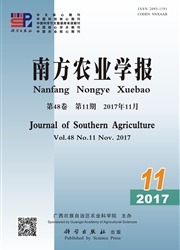

 中文摘要:
中文摘要:
【目的】从分子生物学水平对独龙牛的瘤胃纤维素酶基因资源进行筛选及酶学特性研究,为后续开发利用新的纤维素酶提供参考依据,也为揭示瘤胃微生物降解纤维素的作用机理打下基础。【方法】提取独龙牛瘤胃微生物中的大片段基因组DNA,构建瘤胃微生物基因组文库,并进行纤维素酶活性筛选,筛选获得的高活性基因经测序后进行生物信息学分析与酶学性质研究。【结果】从独龙牛瘤胃中共获得20352个阳性克隆,白斑率达92%,构建的瘤胃微生物基因组文库容量899.6 Mb,空载率1.82%。从瘤胃微生物基因组文库筛选获得2个具有纤维素酶活性的阳性克隆(B1和B2),其中,B1基因序列长1230 bp,编码409个氨基酸,基因编码产物与来自Ruminococcus albus纤维素酶基因编码产物(β-1,4-内切葡聚糖酶,GenBank登录号P23661.1)的覆盖率高达99%,其同源性高达97%;B2基因序列长1002 bp,编码333个氨基酸,基因编码产物与Uncultured microorganism纤维素酶基因编码产物(纤维糊精酶,GenBank登录号ADB80112.1)的覆盖率高达99%,其同源性为83%。B1和B2基因可在Rosetta原核表达宿主菌中成功诱导表达,B1纤维素酶的最适pH为6.0,最适温度40 ℃;B2纤维素酶的最适pH为6.0,最适温度40~50 ℃。【结论】从构建的独龙牛瘤胃微生物基因文库中筛选获得2株具有较高活力的纤维素酶(B1和B2),其中,B1为β-1,4-内切葡聚糖酶,而B2为新的纤维糊精酶,可为纤维素的体外降解提供新型材料。
 英文摘要:
英文摘要:
【Objective】Rumen bacteria cellulase gene resources of Gayal were selected and enzymatic characteristics were studied from molecular biology level, so as to provide reference for development and utilization of new cellulases, and lay foundation for revealing the machenism of cellulose degradation. 【Method】Large fragment genome DNA was extracted from Gayal rumen microorganisms to establish rumen microorganism gene library and select cellulase activity. The selected genes with high activity were sequenced, and studied in bioinformatics and enzymatic characteristics. 【Result】20352 positive clones were obtained, the white spot rate reached 92%, the library capacity was 899.6 Mb, no load rate was 1.82%. Two positive clones with cellulase activity were obtained(B1 and B2). B1 gene sequence length was 1230 bp, encoding 409 amino acids, the coverage rate of its encoding product and encoding product from Ruminococcus albus cellulase gene(β-1,4-endoglucanase, GenBank accession number P23661.1) reached 99%, and their homology was up to 97%. B2 gene sequence length was 1002 bp, encoding 333 amino acids, coverage rate of its encoding product and encoding product from Uncultured microorganism cellulase gene(cellodextrinase, GenBank accession number ADB80112.1) reached 99% and homology was 83%. B1 and B2 genes could be induced in Rosetta prokaryotic expression host bacteria. The optimum conditions for B1 cellulase were pH 6.0 and temperature 40 ℃, and for B2 cellulase were pH 6.0 and temperature 40-50 ℃. 【Conclusion】Two strains with high-activity cellulase(B1 and B2) are selected from rumen microorganism gene library established. B1 is β-1,4-endoglucanase and B2 is cellodextrinase. They can serve as new materials for degradation of crude fiber in vitro.
 同期刊论文项目
同期刊论文项目
 同项目期刊论文
同项目期刊论文
 期刊信息
期刊信息
